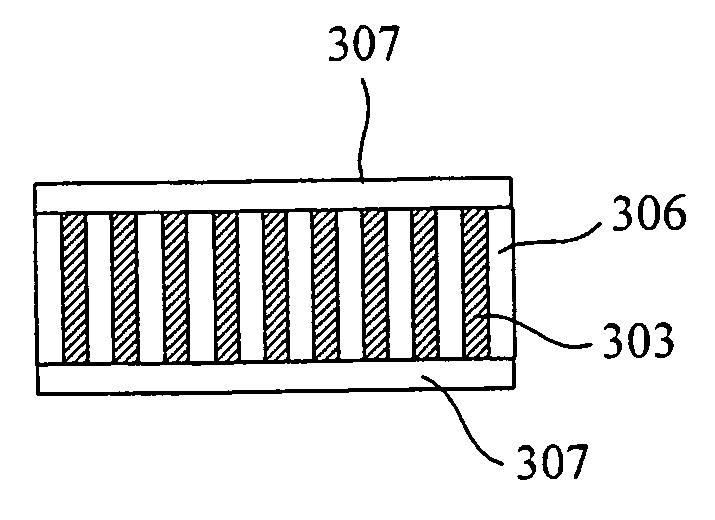Structure of polymer-matrix conductive film and method for fabricating the same
a technology of polymer matrix and conductive film, which is applied in the direction of nanoinformatics, semiconductor/solid-state device details, coupling device connections, etc., can solve the problems of z-axis conductive film not being used in flip-chip packages of less than 30 m pitch, size cannot be reduced further,
- Summary
- Abstract
- Description
- Claims
- Application Information
AI Technical Summary
Benefits of technology
Problems solved by technology
Method used
Image
Examples
Embodiment Construction
[0028] The present invention provides a universal Z-axis conductive film, which comprises a polymer matrix and a plurality of conductive lines less than micro-sized. The present Z-axis conductive film is suitable for a package of a semiconductor device in 45 nm technology node. The polymer matrix can be made of a material with a low Young's modulus to aid as a stress buffer during the subsequent packaging of the semiconductor device. In addition, the structure and composition of the conductive lines can be varied such that the present Z-axis conductive film can connect electrically with the chip and the substrate by bonding. The jointing resistance can thus be lowered.
[0029] However, it is necessary to keep Z-direction parallel of the conductive lines so as to maintain good insulation of the present Z-axis conductive film in X-Y directions. However, the diameter of the currently-used conductive lines is approximately 200 nm (nanometers) or less and their length is 10 μm (micrometer...
PUM
| Property | Measurement | Unit |
|---|---|---|
| size | aaaaa | aaaaa |
| size | aaaaa | aaaaa |
| size | aaaaa | aaaaa |
Abstract
Description
Claims
Application Information
 Login to View More
Login to View More - R&D
- Intellectual Property
- Life Sciences
- Materials
- Tech Scout
- Unparalleled Data Quality
- Higher Quality Content
- 60% Fewer Hallucinations
Browse by: Latest US Patents, China's latest patents, Technical Efficacy Thesaurus, Application Domain, Technology Topic, Popular Technical Reports.
© 2025 PatSnap. All rights reserved.Legal|Privacy policy|Modern Slavery Act Transparency Statement|Sitemap|About US| Contact US: help@patsnap.com



